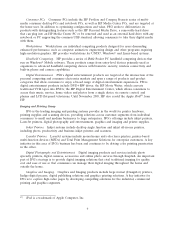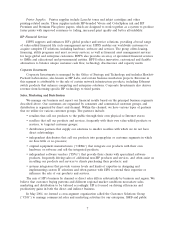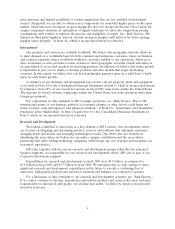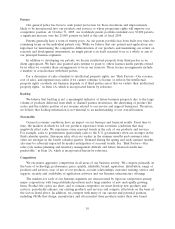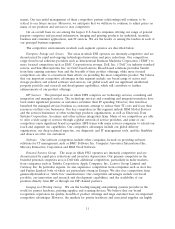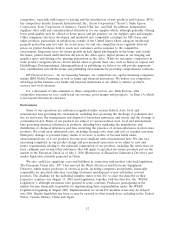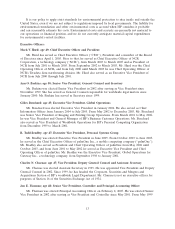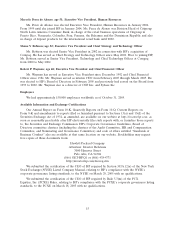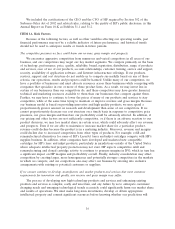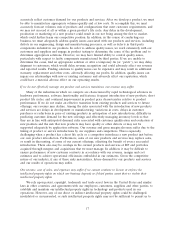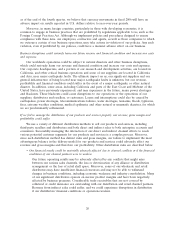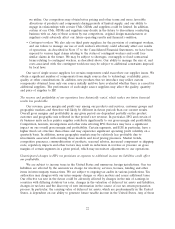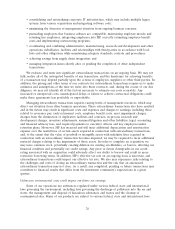HP 2005 Annual Report Download - page 20
Download and view the complete annual report
Please find page 20 of the 2005 HP annual report below. You can navigate through the pages in the report by either clicking on the pages listed below, or by using the keyword search tool below to find specific information within the annual report.We included the certifications of the CEO and the CFO of HP required by Section 302 of the
Sarbanes-Oxley Act of 2002 and related rules, relating to the quality of HP’s public disclosure, in this
Annual Report on Form 10-K as Exhibits 31.1 and 31.2.
ITEM 1A. Risk Factors.
Because of the following factors, as well as other variables affecting our operating results, past
financial performance may not be a reliable indicator of future performance, and historical trends
should not be used to anticipate results or trends in future periods.
The competitive pressures we face could harm our revenue, gross margin and prospects.
We encounter aggressive competition from numerous and varied competitors in all areas of our
business, and our competitors may target our key market segments. We compete primarily on the basis
of technology, performance, price, quality, reliability, brand, reputation, distribution, range of products
and services, ease of use of our products, account relationships, customer training, service and support,
security, availability of application software, and Internet infrastructure offerings. If our products,
services, support and cost structure do not enable us to compete successfully based on any of those
criteria, our operations, results and prospects could be harmed. Unlike many of our competitors, we
have a portfolio of businesses and must allocate resources across these businesses while competing with
companies that specialize in one or more of these product lines. As a result, we may invest less in
certain of our businesses than our competitors do, and these competitors may have greater financial,
technical and marketing resources available to them than our businesses that compete against them.
Further, we may have to continue to lower the prices of many of our products and services to stay
competitive, while at the same time trying to maintain or improve revenue and gross margin. Because
our business model is based on providing innovative and high quality products, we may spend a
proportionately greater amount on research and development than some of our competitors. If we
cannot proportionately decrease our cost structure on a timely basis in response to competitive price
pressures, our gross margin and therefore our profitability could be adversely affected. In addition, if
our pricing and other factors are not sufficiently competitive, or if there is an adverse reaction to our
product decisions, we may lose market share in certain areas, which could adversely affect our revenue
and prospects. Even if we are able to maintain or increase market share for a particular product,
revenue could decline because the product is in a maturing industry. Moreover, revenue and margins
could decline due to increased competition from other types of products. For example, refill and
remanufactured alternatives for some of HP’s LaserJet toner and inkjet cartridges compete with HP’s
supplies business. In addition, other companies have developed and marketed new compatible
cartridges for HP’s laser and inkjet products, particularly in jurisdictions outside of the United States
where adequate intellectual property protection may not exist. HP expects competitive refill and
remanufacturing and cloned cartridge activity to continue to pressure margins in IPG, which in turn has
a significant impact on HP margins and profitability overall. Finally, industry consolidation may affect
competition by creating larger, more homogeneous and potentially stronger competitors in the markets
in which we compete, and our competitors also may affect our business by entering into exclusive
arrangements with existing or potential customers or suppliers.
If we cannot continue to develop, manufacture and market products and services that meet customer
requirements for innovation and quality, our revenue and gross margin may suffer.
The process of developing new high technology products and services and enhancing existing
products and services is complex, costly and uncertain, and any failure by us to anticipate customers’
changing needs and emerging technological trends accurately could significantly harm our market share
and results of operations. We must make long-term investments, develop or obtain appropriate
intellectual property and commit significant resources before knowing whether our predictions will
16


